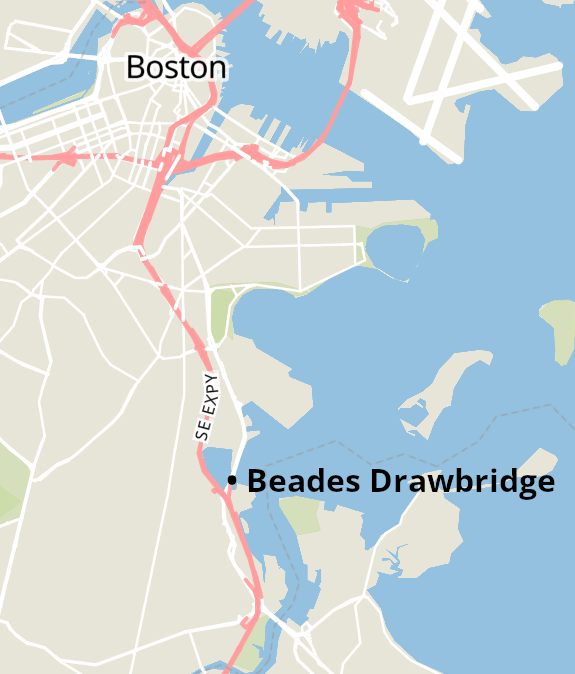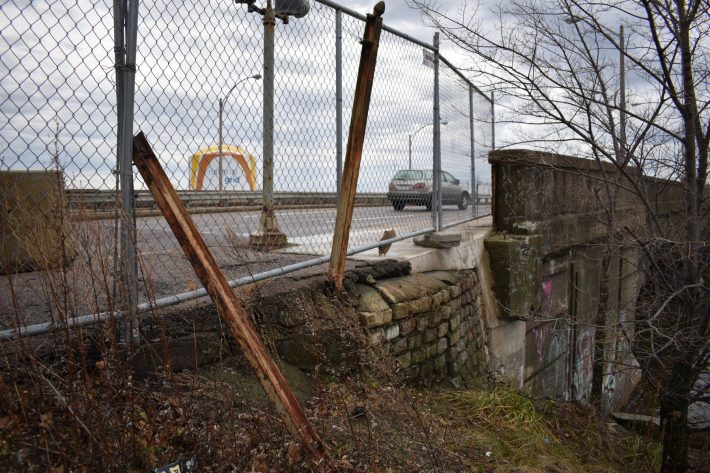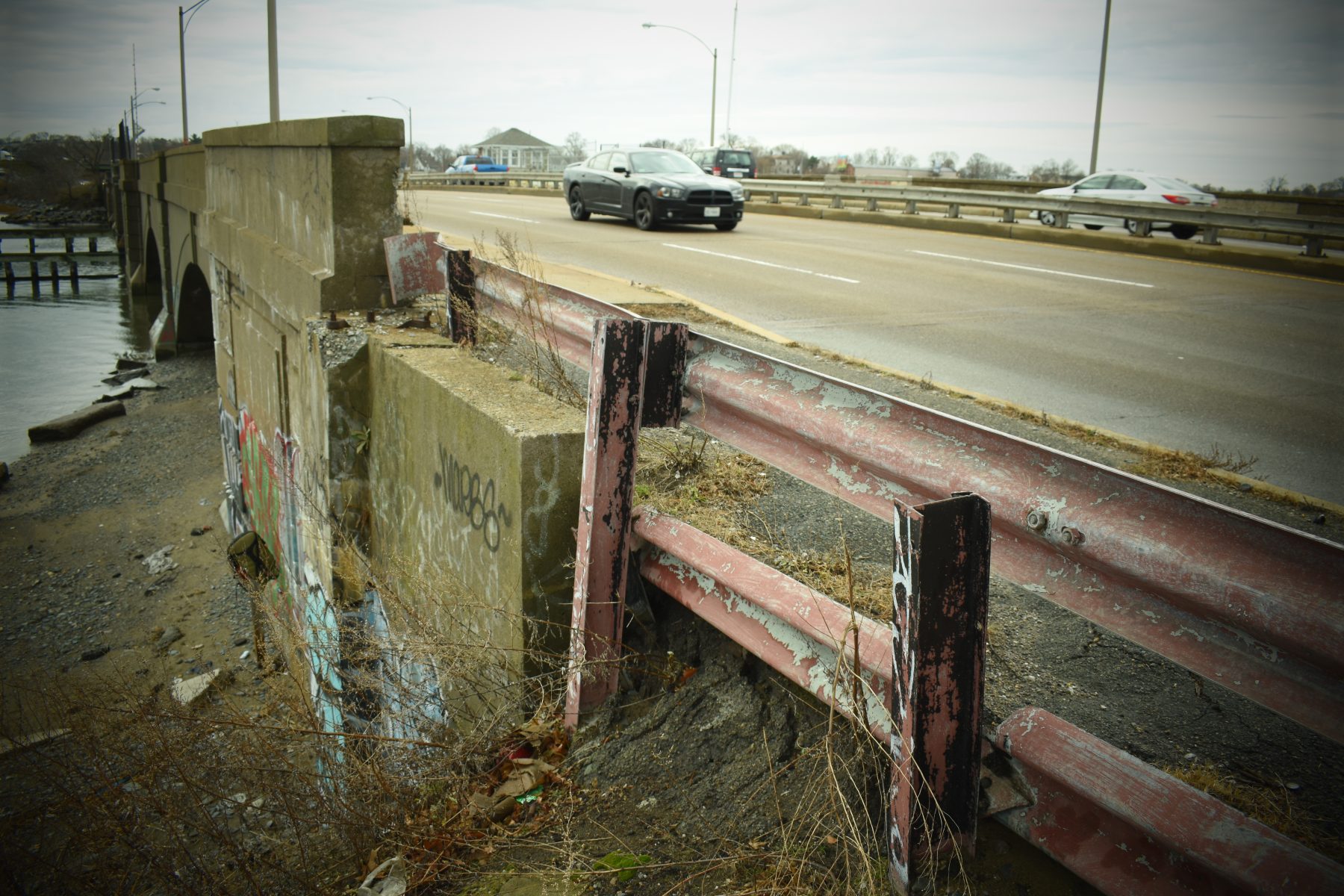After Boston University professor David Jones of Milton died on a MassDOT-owned staircase next to the JFK/UMass Red Line station last fall, the Deputy Chief Engineer of the Department of Conservation and Recreation (DCR) flagged his concerns about another poorly-maintained bridge in the neighborhood: the Beades drawbridge on Morrissey Boulevard.
Internal email discussions in the days following Jones's death reveal confusion and finger-pointing among the different state agencies that maintain balkanized control over transportation infrastructure in the Boston region.
On Tuesday, Sept. 14th, three days after Jones's death, Jeff Parenti, DCR’s Deputy Chief Engineer, wrote to his colleagues to dispute initial reports that suggested his agency should have been responsible for the broken staircase.
“I don’t think the stairs are ours either," wrote Parenti. "Naturally the MBTA threw us under the bus in the (Boston) Globe story today… I am betting this structure was orphaned after the transfer – not explicitly listed in the documents and no one claimed it.”
Then, Parenti concluded his email with his colleagues with a warning:
"This incident gives me new motivation on the Beades issue."
Parenti appears to be referring to the Beades drawbridge, which lies about one mile south of the JFK/UMass Red Line station and carries Morrissey Boulevard over Dorchester Bay Basin, next to National Grid's rainbow-swash storage tank.

The drawbridge was originally built in the 1930s, and widened in the 1950s. According to state inspection reports, the Beades drawbridge has lots of repair needs, some of which are considered urgent. And, like the broken staircase next to the JFK/UMass station, the responsibility for keeping the Beades Bridge in safe condition straddles two bureucracies: the DCR, which controls Morrissey Boulevard on either side of the bridge, and MassDOT, which controls the bridge itself.
Most bridges along DCR roadways belong to MassDOT, after a 2009 transportation reform bill transferred dozens of aging DCR-controlled bridges to MassDOT.
That transfer was supposed to improve maintenance and facilitate repair work by giving DCR's bridges to a larger, better-funded agency.
And some bridges have indeed gotten safer under MassDOT's control: for instance, after a truck driver killed Boston University graduate student Meng Jin, MassDOT reduced the number of motor vehicle lanes to make room for flexpost-buffered bike lanes on Charles River Dam Road, a former DCR roadway that spans the Charles River between Boston and Cambridge.
But in other cases, like the staircase outside the JFK/UMass station, the transfer seems to have created gray areas of responsibility where both agencies neglect acute maintenance needs.
"I’ve lived here 10 years and it’s been in terrible shape this entire time," Jane Acheson, a Dorchester resident who crosses the Beades Bridge regularly, told StreetsblogMASS. "Years ago, there was old iron fencing that was falling apart. They put temporary fencing up and we thought it would be fixed soon, but it’s just stayed there for years, and now that’s also rusting and falling over."
A MassDOT bridge inspection conducted on June 4, 2021 noted several "severe" deficiencies on the Beades Bridge, including failures of the drainage systems and in the masonry of the bridge's stone piers.

The inspection report also notes urgent repair needs on the sidewalks and guardrails that connect to the bridge, on the embankments under DCR's jurisdiction.

The inspection report notes that several of those sidewalks were undermined from erosion (particularly on the southwest approach to the bridge, pictured at left) and that they are gradually sinking below the level of the bridge's sidewalks, creating vertical gaps of up to 4 inches where DCR's jurisdiction meets MassDOT's.
MassDOT's inspectors also noted "multiple areas of hit damage" from crashes and "complete failure" of some sections of guardrail on the bridge embankments.
Those sidewalks and guardrails both merited repairs "ASAP," according to the inspectors.
Some neighborhood residents who use the bridge regularly told StreetsblogMASS that some limited repair work happened over the past summer (the photo above shows some relatively new concrete spanning the gap between DCR's asphalt sidewalk and the MassDOT-controlled bridge sidewalk on the southeastern approach to the bridge).
But by December, when we took the photographs illustrating this article, many of the issues that merited "urgent" attention according to the June inspection remained unaddressed: there were still broken guardrails, and there were visible gaps, cracks, and undermined pavement evident on many sidewalk segments connecting to the bridge (see photos above).
In December, two days after StreetsblogMASS asked a DCR spokesperson, via email, whether regular bridge users should be concerned about what the agency's Deputy Chief Engineer referred to as "the Beades issue," a small construction crew installed a row of concrete jersey barriers between the sidewalks and the roadway on the approaches to the bridge – possibly in response to the inspection's assessment of the guardrails.
The next day, a DCR spokesperson told StreetsblogMASS, via email, that "DCR has taken short term measures to begin addressing sidewalk issues, including installing concrete barricades along Morrissey Boulevard approaching the Beades Bridge. Furthermore, DCR is in the process of developing longer term solutions to the sidewalks located near the bridge."
StreetsblogMASS also spoke with several neighborhood residents to find out whether they feel safe using the bridge, in light of the staircase failure that killed David Jones near the JFK/UMass station.
Acheson, the Dorchester resident who told us how long the "temporary" sidewalk fencing has been up, was relatively unperturbed.
"If it's going to go down, it’s probably going to go down under a heavier vehicle," she told StreetsblogMASS. She also expressed faith that if there were an imminent safety hazard, MassDOT or DCR would close the bridge entirely.
Meghan Walsh, a Dorchester residents who drives on the bridge almost daily and runs across it about once a week, is less concerned about the bridge collapsing than she is about tripping on the broken sidewalk, or getting hit by a car.
"The sidewalk is so bad I’m often afraid I’m going to trip and break an ankle," said Walsh. "And then the sidewalk crosses the off-ramp for I-93 with very fast traffic that’s very dangerous."
“I hate this thing. I want it to go away," says Ryan Murphy, a Savin Hill resident who uses the bridge frequently, both in a car and on foot. "It seems ridiculous to try and maintain this bridge.”
It's likely that Murphy will get his wish someday: between its deterioration and lack of accommodation for bikes, pedestrians, and wheelchair users, it's hard to imagine MassDOT ever salvaging the Beades bridge.
But, in spite of its many issues, designing a replacement isn't anywhere on MassDOT's current workplan.
DCR, meanwhile, has initiated and subsequently abandoned a plan to rebuild the length of Morrissey Boulevard with fewer car lanes and dedicated paths for bikes and pedestrians. And any plan to replace the Beades Bridge is likely to be contingent on a decision about what the future Morrissey Boulevard will look like.
In March 2021, DCR, MassDOT, the City of Boston, and developers of the proposed Dorchester Bay City project announced a new planning study for the Boulevard, but nearly a year has passed since then, and there have been no public announcements about the plan's process or status.






